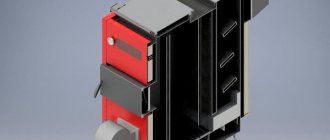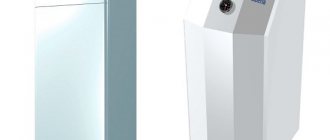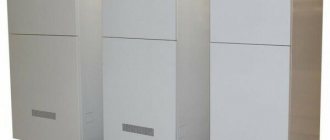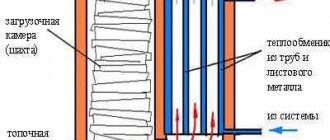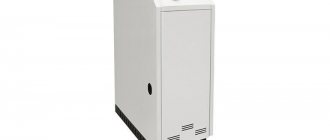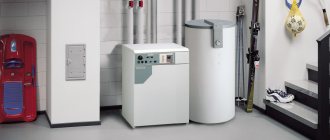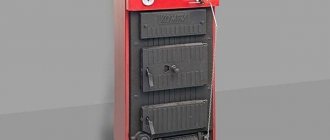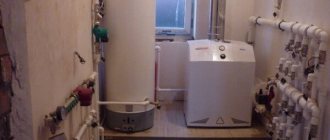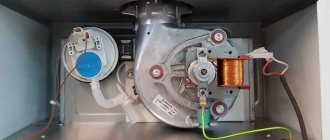Home / Solid fuel boilers
Back
Published: 08/10/2019
Reading time: 6 min
0
5409
Mine boilers (MC) with long-burning pyrolysis type or Kholmov boilers are one of the types of solid fuel heat generators. They belong to the class of energy-independent and efficient units, with forced or natural movement of the gas-air environment.
Typically, mine boilers are manufactured at industrial sites, however, today there are many designs made by hand by craftsmen in compliance with the requirements of regulations and standards in the field of manufacture and safe operation of boiler plants.
Many devices are equipped with energy-efficient features with an additional water heating circuit and storage tank.
- 1 Kholmov's boiler
- 2 The principle of operation of the boiler
- 3 Advantages and disadvantages
- 4 Manufacturing a mine pyrolysis boiler 4.1 Algorithm for creating a boiler with your own hands.
Wood-fired mine boiler: description and features
The unit has high heat transfer, quickly heats the room, and is easy to maintain. The design of the firebox resembles a shaft and holds a large amount of firewood. One load of fuel is enough for 8-12 hours of operation of the heat generator.
The blower is designed in such a way that little air is supplied . There is not enough of it to ignite all the fuel, so the fire is localized in the lower layer. A fresh portion of firewood is supplied continuously. The combustion does not stop until all the fuel is gone. Due to this feature, the units in question are called long-term bottom-burning boilers.
The top layer of firewood smolders, forming pyrolysis gases. They are drawn by air into the secondary chamber, where they burn. The thermal energy of gases and open flames heats the heat exchanger.
Known analogues
In addition to the previously listed “Nedelka”, LIEPSNELĖ, Stropuva, “Stimul”, the most often mentioned in comparison are the “Peresvet” boilers, which are sold at approximately the same prices.
In terms of fuel combustion efficiency, they are almost identical, however, they have much smaller fireboxes (and this means a shorter burning time of one load), as well as a less practical combustion shaft design, which implies the use of much more fragmented logs 36-42 cm long. Otherwise, it is worth noting that that Peresvet mine boilers are much more efficient when burning pellets, and also have a maximum permissible operating pressure of 1.5 bar.
BoilersReviewBoiler ManufacturersSolid Fuel Boilers
Design and principle of operation of the boiler
There are several types of mine heat generators, differing in the design of the combustion chamber. One of the most popular is the Kholmov boiler, named after the inventor.
It consists of:
steel body;
- fuel mine;
- compartment with a heat exchanger;
- doors;
- grate;
- ash pan;
- chimney pipe;
- threaded pipes for connecting water heating.
Volatile units are equipped with a smoke exhauster, a controller that controls the combustion process, and a safety system. Units that operate without electricity are in great demand. The mode is controlled by a thermostat.
The mine wood heat generator has 2 vertical chambers: combustion and heat exchanger. The firebox is located at full height, firewood is loaded through the hatch from above. The second compartment houses the pipes through which the coolant circulates for the water heating system.
Heat generation occurs in 2 ways: from full combustion of fuel and afterburning of pyrolysis gases in the lower part of the secondary compartment. Little air flows through the ash pan, the fire covers only the lower layer of firewood up to 20 cm high, the rest smolder. In place of the burnt fuel, under its own weight, it slowly settles into the heat and the next portion is ignited.
Between the firebox and the second chamber there is a vertical partition with a small gap at the bottom. Through this hole, air is sucked into the flame. Here the highest temperature reaches +800° C. The released energy is transferred to the heat exchanger.
Due to the high temperature, organic compounds are formed from the smoldering wood that is on top. Together with the smoke, they are drawn in by the air entering through the ashpit, pass through the coals, turning into pyrolysis gases. They are burned in the second chamber, giving off heat to water circulating through the pipes.
How to heat properly
To realize the benefits of a shaft boiler and increase the efficiency of heat transfer, two points are important: the quality of the fuel and proper installation. Hardwood (for example, coniferous) firewood contains a lot of resins, which accumulate on the walls of the chambers and reduce efficiency. Wood briquettes and pellets are easy to use, burn well, but their price is higher.
Ignition and adjustment of the boiler take a little time, but the quality of the unit’s operation depends on the correct completion of this stage.
Follow a simple algorithm:
- They put a little fuel on the grate and set it on fire, like in a wood-burning stove. After a few minutes, the flame flares up. When it becomes strong, the boiler enters operating mode.
- Reload fuel. The unit begins to operate in pyrolysis mode.
At least half of the stack should be dry firewood. Logs of high humidity are placed on top: by the time they burn, they have time to dry.
A common mistake made by users is incorrectly stacking firewood, which causes it to get stuck in the shaft. The boiler is designed on the principle of bottom combustion, so the fuel must lower itself to the heat.
To prevent combustion from being interrupted, the logs should be slightly shorter than the distance between the walls of the loading compartment. The firewood is laid across the shaft opening: then they can freely fall down.
How to increase burn time
Many people want to increase the operating time of the heat generator from one load of fuel in order to replenish the supply less often. Two common methods are used: wet firewood and minimal air supply.
Attention: it will not be possible to significantly increase the burning time . Such methods have more disadvantages than advantages.
For the most efficient operation of the unit, boiler manufacturers recommend using firewood with a moisture content of no higher than 20%. Raw fuel reduces boiler efficiency because part of the energy is spent on moisture evaporation. In addition, a lot of soot and resin are formed, all of which settles on the walls, reducing the efficiency of heating water in the heat exchanger. The gas channels narrow and the boiler smokes.
Equipment manufacturers allow the use of fuel with a moisture content of up to 45% or higher, taking into account the possible negative consequences of such use.
A similar result is caused by cutting off the oxygen supply below the normal level. Combustion slows down, the wood smolders, and excess soot is formed, which settles on the walls, reducing the efficiency of heat transfer. Closing the damper on the chimney leads to similar consequences.
Efficient operation of the boiler is possible at 60-90% power. It is possible to increase the burning time, but within small limits. If this is abused, the house will not warm up as well, and fuel costs will be higher.
Features of installing roller blinds
When installing roller blinds, there is no need to drill mounting holes, which undoubtedly simplifies the entire process of hanging the equipment. There are two types of fastenings for roller window systems:
- Fastening with hooks that simply cling to the top of the sash.
- Fastening equipment with double-sided construction tape.
Detailed recommendations for installing curtains with step-by-step instructions are included with each purchased product. By following the instructions for assembling curtains offered by the manufacturer, you can easily and quickly complete the work yourself.
When installing roller blinds, be sure to use a building level; this will protect against distortions and help secure the curtains as accurately as possible.
Advantages and disadvantages
Main advantages compared to other types of boilers:
- Ability to burn fuel of any quality. In addition to firewood, wood briquettes, pellets, and wood processing waste are used.
- Efficiency reaching 85%.
- Ability to adjust power.
- Long-term operation without supplying additional fuel.
- Convenient design with separate hatches for loading firewood and removing ash.
- Operational safety. The possibility of carbon monoxide entering the room is zero.
Disadvantages include increased soot formation and tar deposition on the walls. Periodic cleaning is required to maintain optimal heat output. In addition, the large size and weight of the equipment complicate installation.
Advantages
A boiler made of brick is considered a simple and effective heating structure, which is advisable to use for heating private houses. The advantage of such a structure is the possibility of making it yourself, which allows you to save a lot, as well as be confident in the quality of the materials used and the finished boiler. The manufacturing process itself consists of a minimum number of steps that do not require a large amount of welding work. Having purchased a ready-made heat exchanger, do not use welding. A brick boiler is multifunctional, as it can be used as a heating device for rooms. Additionally, as a hob for cooking.
In addition, such a boiler has the ability to maintain the required coolant temperature for a long time, allowing you to maintain a healthy and comfortable atmosphere in the room. A brick kiln allows you to burn even plastic or rubber waste. However, it is important to know that the firebox should not contain more than 1/3 of the total amount of fuel.
How to make a mine boiler at home
There are many drawings of long-burning units for self-production.
It is impossible to completely replicate an industrial design, but many craftsmen manage to create an analogue.
To assemble a Kholmov boiler at home, you will need to make:
- firebox;
- loading shaft;
- ash chamber;
- grate;
- heat exchange compartment;
- doors;
- dampers;
- chimney.
The most important thing is to make the heat exchanger correctly. If you place it too low, the boiler will instantly boil, which will lead to unpredictable consequences.
Where to buy a long-burning coal boiler for heating a private home
In Moscow
- Stoves-Fireplaces – st. Yubileinaya, 4 building A, tel. +7 (495) 215–56–94.
- Comfort - Dmitrovskoe highway, 100, building 2, tel. +7 (495) 921–37–61.
In St. Petersburg
- TechnoDom - 57 Stachek Ave., Komsomolskaya Square, tel. +7 (812) 671–00–88.
- Kit-Teplo - st. Litovskaya 8, +7 (812) 295–00–05, +7 (812) 248–18–88.
In conclusion, it is worth saying that the efficiency and economy of the heating system depends not least on the skill of the user, therefore, in order for a long-burning coal boiler to serve well for more than one season, it is necessary to learn how to properly operate the equipment and care for it.
Long burning boilersSolid fuel boilersCoal boilers
Step-by-step instructions for making a wood-fired mine boiler
They start by studying the drawing, after which they transfer the dimensions of the parts onto sheet metal. The elements are cut out and the body is welded.
Next, proceed to the manufacture and installation of internal parts:
- A partition is cut to size for installation between the boiler chambers. Holes are made in it: on top and slightly above the grate.
- The part is installed inside the body and welded.
- On the firebox side, a valve is installed on the upper hole of the partition. The chimney pipe is installed on the reverse side.
- Steel grates are welded: cast iron ones quickly deform. You can make them yourself from sheet metal or buy them.
- A hole for the ash pan is cut out in the lower part of the firebox. A similar operation is performed in the wall of the heat exchanger chamber.
- Necks are welded to the holes made, protruding outward by 6 cm and inward by 3 cm.
- Prepare the base for the water jacket: corners are welded horizontally from the inside of the second compartment. The distance to the top should be 4 cm, the bottom row should be located level with the bottom of the afterburning chamber.
- A water jacket and a pipe heat exchanger are installed. The finished part is inserted inside and scalded.
- In the afterburning chamber, the bottom is welded at the same level as the grate. At the internal partition, a third of the part is located horizontally, then it rises according to the drawing.
- A hole is cut above the bottom for the air pipe. They make a lot of holes in it and weld it into the body. The pipe extends 60 mm outwards, and there are no holes in this section.
To make it more convenient to install the heat exchanger, the side of the housing on the side of this chamber is welded after installing the water jacket.
The inside of the boiler chambers is lined with fireclay bricks. For the passage of gases, holes are left opposite those made in the metal.
Manufacturing a heating device - assembly sequence
When assembling with our own hands, we use the drawings and adhere to the specified dimensions. The sequence is as follows:
- We cut out the body from 4 mm metal: bottom, side walls, lid, doorways. Everything is grabbed onto the bottom, which extends to the sides, as in the drawing. Inside, we weld the corners, which will serve as a shelf for the grate.
- We carefully weld the joints and proceed to the water jacket made of 3 mm metal. It extends 20 mm from the walls of the body and to install it, we weld steel strips onto the body. We weld the casing to them.
- Installation of flame tubes on top of the boiler. We cut holes in the back and front walls, insert several pipes, and weld them at the ends.
- We cut out the doors, weld two strips from the inside, and lay asbestos between them for compaction. We cut grates measuring 360×460 mm from the corners and weld them to the shelves with the outer corner.
- We cut fittings into the walls of the tank for the supply and return pipelines and the smoke duct pipe. We weld the air duct from a 40x60 mm profile pipe. A fan will be attached to it through a flange. The air entry is made through the rear wall.
- We weld door hinges and bookmarks to attach the decorative frame. We wrap the boiler tank with basalt insulation and secure it with a cord. We fasten the frame with self-tapping screws to the bookmarks and install the doors.
Result of assembling a long-burning solid fuel boiler
We install a fan on the air duct, an electronic unit on top of the boiler, and hide the sensor under the insulation.
Tips and tricks for use
Before launching, tests are carried out: air is pumped under a pressure of 1.5 atm. Observe the seams, previously coated with soapy water, to see if there is any depressurization.
A fully loaded boiler reaches rated power in 20 minutes. An average of 3 kg of firewood is consumed within an hour. The duration of combustion in normal mode depends on the capacity of the hopper.
If the weather does not require high coolant temperatures, many units switch to smoldering mode. Manufacturers advise loading less fuel. Smoldering has a bad effect on the condition of gas ducts and the internal surface of the boiler.
Of all solid fuel units, mine ones are the most convenient, efficient, and unpretentious. For country houses, this is the best solution to the heating problem.
